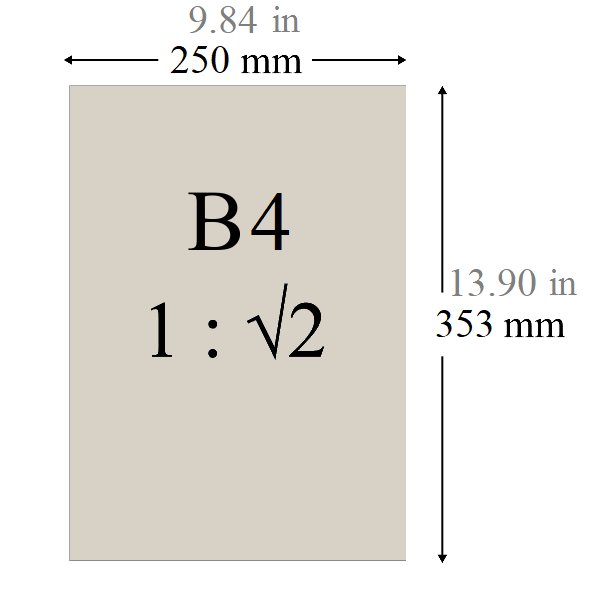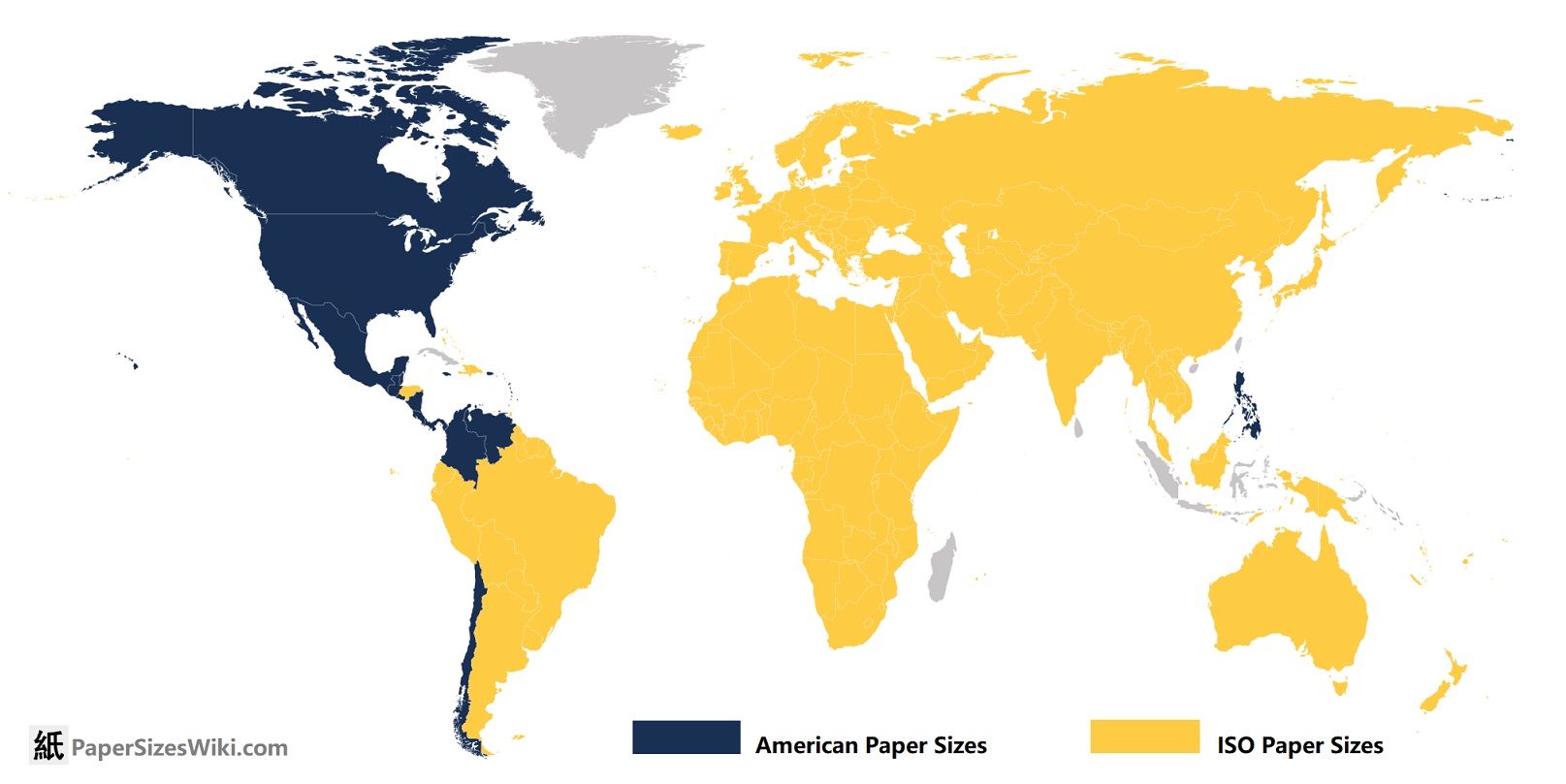What is B4 Paper Size
Definition
The B4 size is a part of the B-series defined by ISO 216, and is a widely used format in countries that follow the metric system, including Europe and Asia. Positioned between B5 and B3, the B4 size is large enough to handle detailed designs and professional prints while remaining relatively compact for ease of use.
Dimensions
The B4 size measures 250 x 353 in mm, 25.0 x 35.3 in cm, and 9.84 x 13.90 in inches. This size is larger than the A4 format (which is 210 x 297 mm or 8.27 x 11.7 inches) but more compact than the larger B3 and B2 sizes. The B4 paper size is often used when the A4 format doesn’t provide enough space, but a larger paper size would be too cumbersome.
The B4 size is popular in both professional and educational settings, as it offers a reasonable balance between usability and print capacity. Its compact size makes it well-suited for office documents, while still being large enough for high-quality print projects.
Layout
Below is the layout of B4 size in inches and mm. It measures 25.0 x 35.3 in cm.

Origin and Historical Context
The B-series paper sizes established by the International Organization for Standardization (ISO), and was developed to provide a more flexible paper size system that allowed for scaling documents without losing proportionality. The series was originally introduced by Germany under the DIN 476 standard in the early 20th century and later became the basis for the international ISO 216 standard.
The B4 size was created as a medium format that would be suitable for documents that require more space than the common A4 size but don’t need the vast area of larger B-series sizes like B3 or B2. With the B-series’ characteristic aspect ratio of 1:√2, the B4 size maintains proportionality when scaled up or down, ensuring a smooth transition between different formats.
Uses of B4 Paper
The B4 paper size is commonly employed in various industries and applications where medium-sized prints are required. Some of its most frequent uses include:
- Brochures and Catalogs: The B4 format is frequently used for high-quality brochures and product catalogs. Its dimensions offer enough space for images, descriptions, and promotional content while still being easy to handle and distribute.
- Documents and Reports: For official documents and reports that need to stand out more than standard A4-sized papers, B4 is an ideal choice. Businesses use it for presentations, training materials, and legal documents that require a larger layout.
- Educational Materials: B4 paper is often used in educational settings, especially for printing instructional materials, worksheets, and handouts that need to display more information or graphics than an A4 sheet can accommodate.
- Booklets: In the publishing industry, B4 paper is used to print booklets, especially those with a medium level of detail. B4 is large enough to hold multiple pages of text and imagery while not being too large to fit in standard binding formats.
- Art Prints: Artists may use B4-sized paper for prints of their works. It allows for larger-than-life reproductions of artwork, such as illustrations, without the overwhelming scale of larger paper formats.
Regions of Use
B4 size is commonly used in European countries, Asian countries, and Australia. For example, Japan and Taiwan use B4 paper size for printing books, calendars, and other business materials. It is also used for printing flyers, posters, and envelopes. The B4 paper size is also popular in Europe for printing magazines and brochures. In Australia, it is used for printing flyers, brochures, and promotional materials.

B4 Size in inches
9.84 x 13.90 in
B4 Size in cm
25.0 x 35.3 cm
B4 Size in mm
250 x 353 mm
B4 Dimensions Table
| Size # | in inches | in mm | in cm |
| B4 | 9.84 x 13.90 in | 250 x 353 mm | 25.0 x 35.3 cm |
B4 Dimensions in pixels
| Size # |
72 dpi/ppi (screen resolution) |
96 dpi/ppi (screen resolution) |
300 dpi/ppi (print resolution) |
| B4 | 709 x 1001 | 945 x 1334 | 2953 x 4169 |
Advantages & Disadvantages
Advantages
B4 paper size offers a relatively large surface area for printing without being too big to manage. B4 paper size is smaller than A4 or Letter paper sizes, but larger than A5 or Half-Letter, making it a good compromise between size and utility. Its compact size makes it easy to handle, store and transport. B4 paper size is also convenient to use for printing two-sided documents.
Disadvantages
However, it may not be compatible with some printers, especially those that are designed to handle only A4 or Letter paper sizes. It may also be challenging to find storage solutions that fit B4 paper size, especially since it does not fit neatly into standard folders or binders.
US Equivalence
In the United States, there is no direct equivalent to the B4 paper size. However, the Letter (8.5 x 11 inches) and Tabloid (11 x 17 inches) sizes are commonly used as substitutes for similar print jobs. When it comes to finding a paper size that closely matches the B4 dimensions, 11 x 14 inches or 12 x 18 inches might serve as reasonable alternatives, though these sizes do not preserve the exact aspect ratio of B4.
For certain tasks that require a slightly larger format than the standard 8.5 x 11-inch Letter size, many US printers opt for 11 x 17 inches or Ledger paper. While these sizes are somewhat larger than B4, they are often used in similar applications like reports, presentations, and brochures.
Main Facts
The B4 paper size, measuring 250 x 353 mm (9.84 x 13.9 inches), is a versatile format used widely across various industries for everything from documents and brochures to educational materials and art prints. It strikes a balance between the smaller A4 and larger B3 formats, making it ideal for medium-scale prints. While there is no direct equivalent in the US standard paper sizes, alternatives such as 11 x 14 inches or 12 x 18 inches are commonly used in its place. The B4 paper size remains an important choice for printing tasks that require a bit more space without the bulk of larger formats.